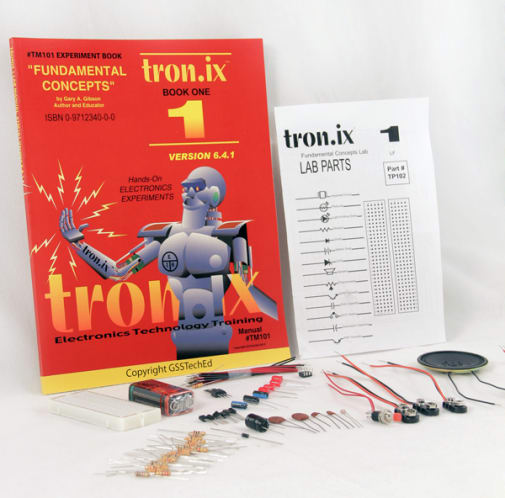My childhood was plagued with overcomplicated electronics kits with massive breadboards and a tangle of resistors. After completing several of the 40 experiments, I feel this kit is much more concise than many and easy to construct. This hands-on lab is designed especially for those who need a knowledge of electronics leading to a career in electronics, computers or robotics. This Tronix Book 1 lab kit will provide a good foundation in basic electronics concepts and components. A 93-page workbook provides 40 briefly described lessons that follow a 3-step process: taking inventory of parts needed; building the circuitry; and performing the experiment (with procedure and observation). Experiments range from basic electronics lessons (how to use the circuit board, reading values, etc.) to component lessons (how diodes, resistors, photocells, transistors, etc. work) to more complicated electronic project lessons. My favorite experiment was the moisture detector. Others include the light controller, police siren and insanity alarm game. Additionally, 13 pages of lessons cover basic DC electronics (Ohm's, Kirchhoff's voltage and current laws, and resistors in parallel and in series). At the end of the workbook are 9 pages of Build-the-Schematic exercises, in which the more advanced student will view a schematic, read the theory behind each item and follow the procedure to build. Students can also fill in the date of each schematic's completion. Parts are identified visually and also according to lab used: includes a 6.5 x 1.5 breadboard, a 9V battery, ceramic disc capacitors, light emitting diodes, an integrated circuits/timer, a photocell, a battery snap, a timer, 3 standard LEDs,2 silicon rectifier, 4 pnp transistors, a speaker, resistors, a diode, a push-button switch, potentiometer, semiconductors, and 20 solid wires at different OHM ratings. While most helpful if learning alongside someone with some electrical experience, the variety of in-depth experiments allow high school students to have plenty of fun while learning ohm's law, circuits in parallel versus series and voltage principals. ~ Steve
Fundamental Concepts of Electronics Technology Education Package
SKU
025970
Grade 7-12
These icons are designed to help you quickly understand and learn important information about our products.
Teaching Method
Traditional
Teacher-centered curriculum commonly used in classrooms that may include a text, teacher manual, tests, etc.
Charlotte Mason
A methodology based on the work of a 19th century educator who maintained that children learn best from literature (Living Books), not textbooks.
Classical
A methodology based on the Latin Trivium (three stages of learning), including the grammar stage (memorization and facts), logic stage (critical thinking), and rhetoric stage (developing/defending ideas).
Unit Study
A thematic or topical approach centered around one topic that integrates multiple subject areas.
Montessori (Discovery)
A methodology based on the work of a 20th century educator that emphasizes student and sensory-driven discovery learning and real-life applications.
Other
Other methodologies
Religious Content
Secular
Contains content contrary to common Christian beliefs (i.e. evolution).
Neutral
Avoids religious or theoretical topics or presents multiple viewpoints without preference.
Christian/Religious
Faith-based or including instructional religious content.
Learning Modality
Auditory
Learns through listening, talking out loud or reading out loud.
Visual
Learns through seeing, prefers written instructions and visual materials.
Kinesthetic/Tactile (Hands-On)
Learns through moving, doing and touching.
Multi-Sensory
Curriculum that employ a variety of activities/components.
Presentation
Sequential
Curriculum progresses through well-defined learning objectives. Emphasizes mastery before moving to the next topic.
Spiral
Topics and concepts are repeated from level to level, adding more depth at each pass and connecting with review.
Conceptual/Topical
Focus is on the “why,” often with a unifying concept as well as specific skills; coverage may be broader.
Teacher Involvement
Low Teacher Involvement
Student-led materials; parent acts as a facilitator.
Medium Teacher Involvement
A mix of teacher-led time and independent student work.
High Teacher Involvement
Teacher-led lessons; may utilize discussions, hands-on activities and working together.
Additional Materials Required
No other materials needed
Everything you need is included.
Other Materials Required
There are additional required resources that are a separate purchase.
Other Materials Optional
There are additional resources mentioned or recommended but are not absolutely necessary.
Consumable
Consumable
Designed to be written in; not reusable.
Non-Consumable
Not designed to be written in; reusable.
Our Price
$42.95 Description
Category Description for Fundamentals of Electronics Kits
Introduce curious learners to the exciting world of electronics with the hands-on kits from Electronix Express. Lab 1 lays the foundation with an understanding of basic electronics. Once the foundation has been laid, expand learning by learning basic digital concepts in Lab 2. Completing the series, Lab 3 guides students to a better understanding of oscillators and amplifiers, which is essential to understanding television and radio transmissions, computer and quartz clocks, and video game audio dynamics.
Details
| Product Format: | Other |
|---|---|
| Grades: | 7-12 |
| Brand: | Gibson Sales Systems |
| Length in Inches: | 9.25 |
| Width in Inches: | 12 |
| Height in Inches: | 2.0625 |
| Weight in Pounds: | 1.3 |
Videos
Reviews

